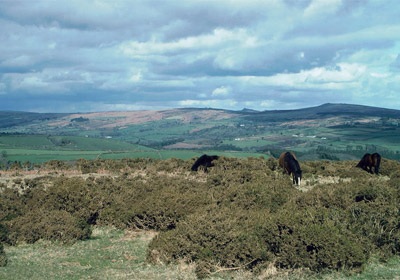Dartmoor, the UK

Wild ponies grazing in Dartmoor © wikipedia, Manfred Heyde
Dartmoor is the southernmost of the UK's National Parks and also the southernmost area of upland vegetation in the UK.
Large areas of Dartmoor are designated under both national and EU legislation, with the core areas of blanket bog and dry heath. The area also delivers a much wider range of ecosystem services and public goods, ranging from an unparalleled density of archaeological remains to clean drinking water, from carbon storage to recreation. Nearly 36 000 ha of Dartmoor are common land grazed by sheep, cattle and ponies. Over half of the registered agricultural holdings in the Park have registered commons rights. For the last 30 years, there has been a unique and Dartmoor-specific commons system of commons governance through the Dartmoor Commoners’ Council.
The major challenges are achieving socio-economic viability and support and regulatory environments which fit well with common land systems.
For more information on the HNV farming systems, challenges and innovations, see the innovations page of Dartmoor.
More info: www.dartmoor.gov.uk
Contact person:
Participatory approach
The Dartmoor Learning Area (LA) and the farmers who live and work within its boundary have a well-defined identity. Part of that identity is a social cohesion that demonstrates itself by a range of social networks, some with their origins over 50 years ago. Put simply Dartmoor farmers meet regularly. With a culture of meetings and an array of social events in place and there was little need to create new networks to deliver the ambitions of HNV-LINK. In fact the existing communication networks may well have significantly contributed to the evolution of the culture of innovation that led to the area being selected as a LA.
The decision was taken at the start of the HNV-LINK initiative to use the existing and established means of communication. At the very beginning of the initiative the proposals were presented to a meeting of the local stakeholders before the project began.
The dominance of common land on the moorland is an important factor in the numerous social networks and their associated communication. Each common usually has an association which oversees the management of the common, and some commons also have an additional and separate association linked to their agri-environment agreement. The Dartmoor wide governance of the common land is provided by the Commoners’ Council. All three strands of governance include regular meetings and other forms of communication.
Away from the moorland the small to medium-sized family run farms have often been owned or tenanted by the same family for many generations. Bonds form between families and this engenders a close community (with exceptions) where information flows relatively freely. The “Dartmoor grapevine” is very effective.
The National Park Authority (DNPA) provides further opportunities for communication with and between farmers. The DNPA holds an annual farmers meeting with guest speakers and discussions of selected themes in addition to the numerous meetings held to address specific issues. Farming matters appear in their various magazines and newsletters including those provided by the Dartmoor Hill Farm Project that is received by all the 600 or so farms within the LA. The Dartmoor Hill Farm Discussion Group still meets regularly having been established by the then MAFF in the late 1950’s and attracts an audience of over 50 farmers.
Many of the innovations identified within the HNV-LINK work attract the attention of local statutory agencies and central government. During the past 18 months senior staff from Defra, including the Secretary of State (23rd August 2017), have visited Dartmoor to learn more of specific innovations, especially Dartmoor Farming Futures. These opportunities are used to promote the innovations and farmers with experience of the innovation are expected to provide the main presentations and provide information on the practical aspects of the innovation.
The HNV-LINK project was promoted at various meetings in the autumn of 2016 until March 2017. A two day event Locally led agri-environment schemes - from a farmer’s perspective was held in March 2017 at which farmers from Dartmoor and the Irish LA (The Burren) presented the various innovations and the ambitions of the HNV-LINK project to an audience of 70 including government staff, NGOs, agencies and other farmers. Since then HNV-LINK updates have continued to be provided at many other local meetings.
| Selected activities | Date |
|---|---|
| Promotion of HNV LINK to local farmers and other stakeholders | Oct 2016-March 2017 |
| Conference on farmer led delivery | 13 & 14 March 2017 |
| Meetings with selected farmers | 31 May/1st June 2017 |
| Workshop/visit from Irish farmers | 13 July 2017 |
| Innovation seminar for local farmers | 1 August 2017 |
| Meeting with Defra officials | 26th January 2018 |
| Workshop with farmers and stakeholders | 2 February 2018 |
| Proposed visit from Welsh farmers | 11 -13 July 2018 |
Gallery
Video
Video of Chairman of Commoners explaining how the project baseline assessment revealed the importance of social and cultural aspects in order to engage with farmers
Disclaimer: This document reflects the author's view and the Research Executive Agency is not responsible for any use that may be made of the information it contains.
Outputs
-
 Dartmoor, the UK LA
Dartmoor, the UK LA
- Baseline Assessment
- Report from the Innovation seminar
- UK Innovation seminar Presentation
- Innovation report
- Participatory approach, Dartmoor, the UK
- Dartmoor, The United Kingdom, HNV-Link Final Conference (Poster)
- Action Plan
(April, 2019)The compilations of the respective reports from all project learning areas - Baseline Assessments, Reports from innovation seminars, and Compendium of Innovation - can be found in 'Outputs'. Reports from the Innovation seminars are in the national languages, all other materials are in English.




